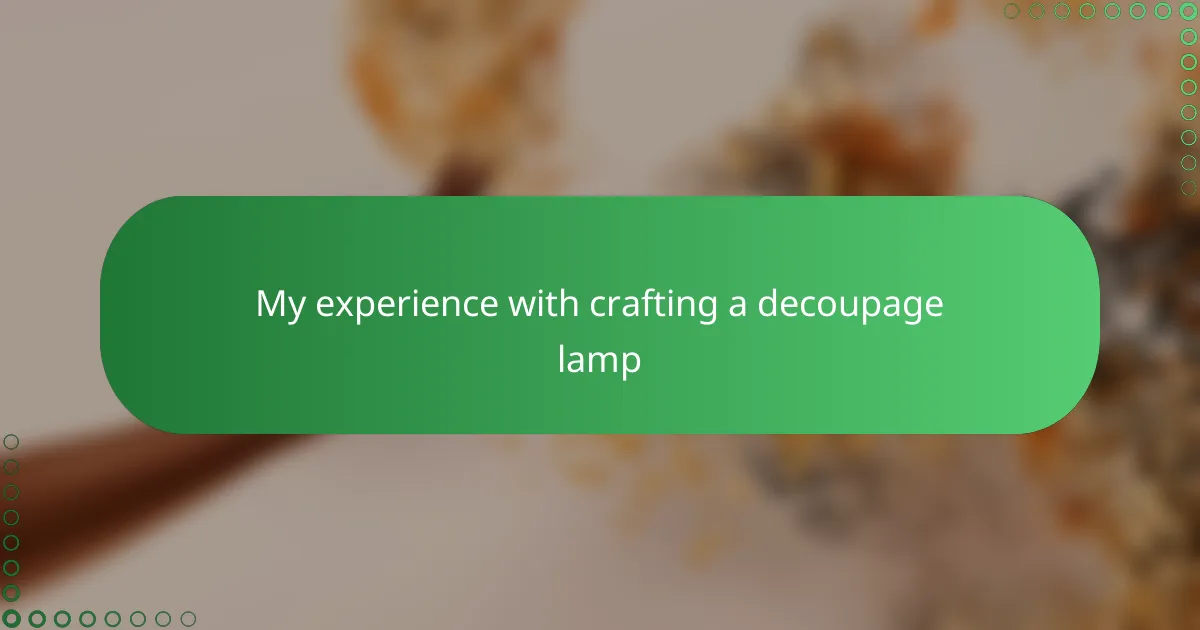Key takeaways
- Handmade paper crafts encourage creativity and provide a calm, rewarding experience without the need for expensive materials.
- Key materials for decoupage lamps include lightweight tissue paper, Mod Podge, and a smooth lamp base, ensuring a neat finish.
- Important tips for successful decoupage include patience between layers, using minimal glue, and careful trimming of edges to avoid wrinkles and improve appearance.
- Creative lamp designs can be enhanced by mixing patterns, using translucent papers for unique light effects, and incorporating personal touches to tell a story.

Introduction to handmade paper crafts
Handmade paper crafts have always fascinated me because they transform simple sheets of paper into tangible pieces of art. Have you ever stopped to think about how much creativity and patience go into cutting, folding, and assembling paper by hand? For me, working with paper feels like giving life to something plain and ordinary.
When I first started exploring handmade paper crafts, I was amazed at the variety of techniques available—from origami to quilling to decoupage. Each method offers a unique way to express ideas and emotions through texture and color. It’s not just crafting; it’s a personal journey that lets you slow down and connect with your creativity.
What I love most is that paper crafts are accessible and inviting. You don’t need fancy tools or expensive materials to start. This simplicity makes it easy to experiment and find joy in making something by hand—an experience that feels both rewarding and calming in a busy world.

Materials needed for decoupage lamps
To get started with a decoupage lamp, I found that the right materials make all the difference. I gathered lightweight tissue paper or napkins with beautiful patterns—these are perfect because they adhere smoothly and let light shine through softly. Could you imagine using thick paper? It just doesn’t work as well; the lamp ends up looking bulky and uneven.
Of course, you’ll need some decoupage glue or Mod Podge. I remember the first time I used regular glue and learned the hard way that it dried too quickly and didn’t give me the flexibility I needed. Mod Podge, on the other hand, creates a smooth, clear finish, sealing the paper gently onto the lamp’s surface. Brushes are essential too; I prefer soft-bristle ones because they help prevent tearing the delicate paper.
Lastly, a plain lamp base with a lampshade to decorate is a must. I once tried using a lampshade with a very textured surface, and it was frustrating to work on. A smooth, simple surface allows the paper to stick better and shows off the design clearly. Don’t forget to have scissors handy for trimming, and if you want, a pencil for sketching out your design. These small tools really make the process easier and more enjoyable.

Step by step decoupage lamp process
The first thing I did was carefully cut out the paper motifs I wanted to use. I remember that moment of anticipation, wondering how the design would look once on the lampshade. Have you ever felt that mix of excitement and nervousness before placing something delicate where you can’t easily fix it?
Next came the fun but sometimes tricky part: applying the glue. I brushed a thin, even layer of Mod Podge onto the lampshade, then gently placed each piece of tissue paper. It felt almost like a dance, smoothing out wrinkles without tearing the delicate paper. I got better with practice, learning to trust my touch rather than rushing.
Finally, sealing everything with another layer of Mod Podge was like giving my lamp a protective hug. It brought out the colors and made the surface glossy without hiding the paper’s texture. When I switched on the lamp and saw the soft glow filtering through my handiwork, I knew all the careful steps were worth it. Have you ever experienced that sweet moment of creation glowing to life?

Tips for successful decoupage crafting
One tip that really changed my decoupage game was to be patient between layers. I used to rush, thinking a quick dry would speed things up, but that often led to wrinkles or bubbles. Have you ever tried smoothing paper that’s still wet? It can be tricky, but letting each layer dry fully made the whole process smoother and less frustrating for me.
Another thing I found helpful was using a soft brush and applying glue sparingly. When I started, I was generous with the glue, thinking more meant better adhesion. In reality, too much glue made the paper soggy and prone to tearing. A light touch, almost like a gentle caress, helped the paper stick firmly without damage—it’s a small detail that made a big difference.
Lastly, trimming the paper motifs close to the edges felt nerve-wracking at first. What if I cut too much? Over time, I realized that neat edges prevent lumps and create a clean look. I even practiced on scrap pieces to build confidence. Have you noticed how careful trimming elevates the entire lamp’s appearance? It’s those little finishing touches that bring your project from good to beautiful.

Common challenges and solutions
One challenge I faced early on was dealing with wrinkles and bubbles under the paper. Have you ever felt that frustration when your carefully placed motif suddenly puckers awkwardly? I learned that applying the glue in thin, even layers and smoothing gently with my fingers or a soft brush made a big difference in avoiding those pesky imperfections.
Another hurdle was preventing the delicate tissue paper from tearing, especially around curved or intricate parts of the lampshade. At first, I was too rough, impatient to finish quickly, and that cost me more than one beautiful piece. Slowing down and embracing a gentle touch turned out to be the key—it’s surprising how much patience shapes a better final result.
Lastly, I struggled with achieving a seamless look at the edges of the paper pieces. I wondered, isn’t trimming just trimming? But I soon realized that precise, careful cutting can elevate the lamp’s appearance dramatically. Practicing on scrap materials built my confidence, transforming this once-daunting task into an enjoyable step that I actually looked forward to. Have you ever noticed how those tiny details make all the difference?

My personal experience with the lamp
When I first lit my decoupage lamp, a wave of satisfaction washed over me—it was a tangible reminder of all the care and patience woven into every layer of tissue paper. Have you ever experienced that moment when your hands create something that not only looks beautiful but also feels like an extension of your creativity? That gentle glow made the whole effort feel deeply worthwhile.
I remember sitting beside the lamp on a quiet evening, watching how the soft patterns danced on my walls, and a sense of calm settled in me. It surprised me how a simple handmade object could change the atmosphere of a room and even my mood. That personal connection truly solidified my love for this craft.
Of course, there were times when I doubted my choices—would the colors blend well in the dim light? Could the paper hold up over time? But seeing that warm, cozy glow reminded me why embracing the imperfections is part of the charm in handmade projects. Have you found that these little moments of unpredictability often lead to the most rewarding outcomes?

Creative ideas for lamp designs
When thinking about creative ideas for lamp designs, I found that mixing patterns and textures can really bring a lamp to life. For example, layering floral motifs with geometric shapes added depth and intrigue to my decoupage lamp, making it a piece that sparked conversation every time someone saw it. Have you ever tried contrasting bold and delicate paper patterns? It’s a surprisingly effective way to create visual interest.
Another idea I loved experimenting with was using translucent papers that let light shine through differently, creating soft shadows and glowing effects. I once used handmade rice paper, which gave my lamp a warm, almost ethereal light that changed as you moved around it. That subtle play of light made the lamp not just a decoration but a mood-setter in my space.
I’ve also enjoyed adding personal touches like cutouts of meaningful words or shapes that tell a story. One time, I crafted a lamp featuring snippets of old letters mixed with botanical prints—it felt like I was illuminating a piece of my own history. What could be more special than a lamp that isn’t just beautiful but also deeply personal?
